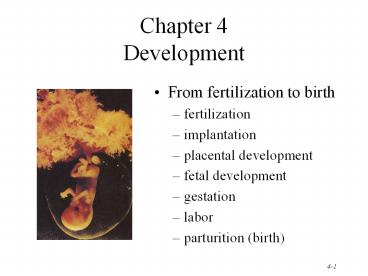Chapter%204%20Development - PowerPoint PPT Presentation
Title:
Chapter%204%20Development
Description:
Chapter 4 Development – PowerPoint PPT presentation
Number of Views:38
Avg rating:3.0/5.0
Title: Chapter%204%20Development
1
Chapter 4Development
- From fertilization to birth
- fertilization
- implantation
- placental development
- fetal development
- gestation
- labor
- parturition (birth)
2
Terminology of Development
- Gestation period
- time span from fertilization to birth (38 weeks)
- Prenatal period (before birth)
- embryological development
- developing human for first 2 months after
fertilization is known as an embryo - all principal adult organs are present
- fetal development
- from 9 weeks until birth is known as a fetus
- by end of 3rd month, placenta is functioning
- Neonatal period is first 42 days after birth
- obstetrics is branch of medicine that deals with
the neonatal period, pregnancy and labor
3
From Fertilization to Implantation
4
Sperm Contact during Fertilization
- Sperm penetrates the granulosa cells around the
oocyte (corona radiata) - Sperm digests its way throughthe zona pellucida
- when ZP3 glycoprotein binds to spermhead, it
triggers the acrosomal reaction(enzyme release) - First sperm to fuse with oocyte membrane triggers
the slow the fast block to polyspermy - 1-3 seconds after contact, oocyte membrane
depolarizes other cells can not fuse with it
fast block to polyspermy - depolarization triggers the intracellular release
of Ca2 causing the exocytosis of molecules
hardening the entire zona pellucida slow block
to polyspermy
5
(No Transcript)
6
(No Transcript)
7
Events Within the Egg
- Sperm entry, triggers oocyte to complete meiosis
II and dump second polar body - Once inside the oocyte, the sperm loses its tail
becomes a male pronucleus - Fusion of male female haploid pronuclei is the
true moment of fertilization - Fertilized ovum (2n) is called a zygote
- zona pellucida still surrounds it
8
Formation of the Morula
- Rapid mitotic cell division of embryo is called
cleavage - 1st cleavage in 30 hours produces 2 blastomeres
- 2nd cleavage on 2nd day
- By 3rd day has 16 cells
- By day 4 has formed a solidball of cells called
a morula
9
Implantation Notice distinct syncytiotrophoblast
and cytotrophoblast layers.
10
First week of development
11
Beginnings of Organ Systems(Gastrulation)
About 8 days of fertilization
12
(No Transcript)
13
Primary Germ Layers
- Day 14 --cells of embryonic disc produce 3
distinct layers - endoderm forms epithelial lining of GI
respiratory - mesoderm forms muscle, bone other connective
tissues - ectoderm develops into epidermis of skin
nervous system
14
Development of the notochordal process
15
(No Transcript)
16
Neurulation
17
Formation of Embryonic Membranes
- Yolk sac
- site of early blood formation
- gives rise to gonadal stem cells (spermatogonia
oogonia) - Amnion
- surrounds embryo with fluid shock absorber,
regulates body temperature prevents adhesions - fluid is filtrate of mothers blood fetal urine
- examine a sample of it for embryonic cells
(amniocentesis) - Chorion
- becomes the embryonic contribution to the
placenta - derived from trophoblast mesoderm lining it
- gives rise to human chorionic gonadotropin (hCG)
- Allantois
- outpocketing off yolk sac that becomes umbilical
cord
18
Development of chorionic villi
19
Placenta Umbilical Cord
- Placenta forms during 3rd month
- chorion of embryo stratum functionalis layer of
uterus - Chorionic villi extend into maternal blood filled
intervillous spaces --- maternal fetal blood
vessels do not join blood does not mix - diffusion of O2, nutrients, wastes
- stores nutrients produces hormones
- barrier to microorganisms, except some viruses
- AIDS, measles, chickenpox, poliomyelitis,
encephalitis - not a barrier to drugs such as alcohol
- Placenta detaches from the uterus (afterbirth)
20
Placenta and umbilical cord
21
Amniocentesis
- Fetal cells from 10 ml sample of amniotic fluid
examined for genetic defects - Test at 14-16 weeks
- Results back in one month
- Needle through abdominal wall uterus
- Chance of spontaneous abortion is 0.5
22
Chorionic Villi Sampling
- As early as 8 weeks
- Results in few days
- Chance of spontaneous abortion 1-2
- 30 mg of placenta removed by suctionthrough
cervix or with needle through abdomen - Chromosomal analysis reveals same results as
amniocentesis
23
Embryonic folding
24
Development of the pharyngeal arches, pharyngeal
clefts, and pharyngeal pouches
25
Developmental Changes
- Read Table 4.2 to get a full description of the
timing of fetal events during development
26
(No Transcript)
27
(No Transcript)
28
Labor and Parturition
- Parturition means giving birth labor is the
process of expelling the fetus - Labor begins when progesterones inhibition is
overcome by an increase in the levels of estrogen - progesterone inhibits uterine contraction
- placenta stimulates fetal anterior pituitary
which causes fetal adrenal gland to secrete DHEA - placenta converts DHEA to estrogen
- estrogen overcomes progesterone and labor begins
29
Stages of Labor
- Dilation
- 6 to 12 hours
- rupture of amniotic sac dilation of cervix
- Expulsion
- 10 minutes to several hours
- baby moves through birth canal
- Placental
- 30 minutes
- afterbirth is expelled by muscular contractions

